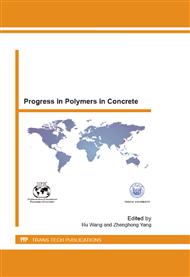[1]
ACI Committee 544, Measurement of Properties of Fiber Reinforced Concrete, ACI Materials Journal. 85-M58, (1988) 583-593, 544.2R-89, Reapproved 2009.
Google Scholar
[2]
ASTM C 78, Standard Test Method for Flexural Strength of Concrete (Using Simple Beam with Third-Point Loading), ASTM International, West Conshohocken, PA , 2007.
DOI: 10.1520/c0078_c0078m-15a
Google Scholar
[3]
ASTM C 1018, Standard Test Method for Flexural Toughness and First-Crack Strength of Fiber-Reinforced Concrete (Using Beam With Third-Point Loading), ASTM International, West Conshohocken, PA, 1997.
DOI: 10.1520/c1018
Google Scholar
[4]
C. D. Johnston, A. Skarendahl, Comparative Flexural Performance Evaluation of Steel Fibre-Reinforced Concretes According to ASTM C 1018, Materials and Structures. 25 (1992) 191-200.
DOI: 10.1007/bf02473063
Google Scholar
[5]
P. Balaguru, R. Narahari and M. Patel, Flexural Toughness of Steel Fiber Reinforced Concrete, ACI Materials Journal. 89 (1992) 541-546.
DOI: 10.14359/4019
Google Scholar
[6]
S. Mindess, L. Chen and D.R. Morgan, Determination of the First-Crack Strength and Flexural Toughness of Steel Fiber-Reinforced Concrete, Advanced Cement Based Materials. 1 (1994) 201-208.
DOI: 10.1016/1065-7355(94)90025-6
Google Scholar
[7]
N. Banthia, J. F. Trottier, Concrete Reinforced with Deformed Steel Fibers Part II: Toughness Characterization, ACI Structural Journal. 92 (1995) 146-154.
DOI: 10.14359/9765
Google Scholar
[8]
A. E. Naaman, F. M. Al Khairi, Bending Properties of High-Early-Strength Fiber Reinforced Concrete, ACI Special Publication. 159 (1996) 351-374.
Google Scholar
[9]
V. Bindiganavile, N. Banthia, Polymer and Steel Fiber-Reinforced Cementitious Composites under Impact Loading – Part 2: Flexural Toughness, ACI Materials Journal. 98 (2001) 17-24.
DOI: 10.14359/10156
Google Scholar
[10]
F. Jeng, M. L. Lin, S. C. Yuan, Performance of Toughness Indices for Steel Fiber Reinforced Shotcrete, Tunnelling and Underground Space Technology. 17 (2002) 69-82.
DOI: 10.1016/s0886-7798(01)00065-7
Google Scholar
[11]
Y. Wu, Flexural Strength and Behavior of Polypropylene Fiber Reinforced Concrete Beams, Journal of Wuhan University of Technology-Mater. Sci. Ed. 17 (2002) 54-57.
DOI: 10.1007/bf02832623
Google Scholar
[12]
O. C. Choi, C. Lee, Flexural Performance of Ring-Type Steel Fiber-Reinforced Concrete, Cement and Concrete Research. 33 (2003) 841-849.
DOI: 10.1016/s0008-8846(02)01093-1
Google Scholar
[13]
P. Balaguru, H. Najm, High-Performance Fiber-Reinforced Concrete Mixture Proportions with High Fiber Volume Fractions, ACI Materials Journal. 101 (2004) 281-286.
DOI: 10.14359/13361
Google Scholar
[14]
N. Banthia, S. M. Soleimani, Flexural Response of Hybrid Fiber-Reinforced Cementitious Composites, ACI Materials Journal. 102 (2005) 382-389.
DOI: 10.14359/14800
Google Scholar
[15]
N. Banthia, V. Bindiganavile, Fiber-Reinforced Shotcrete: Comparing the Properties of Dry- and Wet-Mix Shotcrete Reinforced with Steel Fibers, Concrete International. 29 (2007) 53-58.
DOI: 10.1016/s0958-9465(00)00094-9
Google Scholar
[16]
ASTM C 1609, Standard Test Method for Flexural Performance of Fiber-Reinforced Concrete (Using Beam With Third-Point Loading), ASTM International, West Conshohocken, PA, 2007.
DOI: 10.1520/c1609_c1609m-05
Google Scholar
[17]
D. C. Teychenne, R. E. Franklin, H. C. Erntroy, et al, Design of Normal Concrete Mixes, Second Edition, Building Research Establishment, 1997.
Google Scholar
[18]
Z. H. Guo, X. Q. Zhang, Investigation of Complete Stress-Deformation Curves for Concrete in Tension, ACI Materials Journal. 84-M29, (1987) 278-285.
DOI: 10.14359/1616
Google Scholar
[19]
R. Y. Xiao, C. S. Chin, Flat Slabs at Slab-Column Connection: Nonlinear Finite Element Modelling and Punching Shear Capacity Design Criterion, Journal of Advance in Structural Engineering (ASE). 10 (2007) 567-579.
DOI: 10.1260/136943307782417717
Google Scholar


